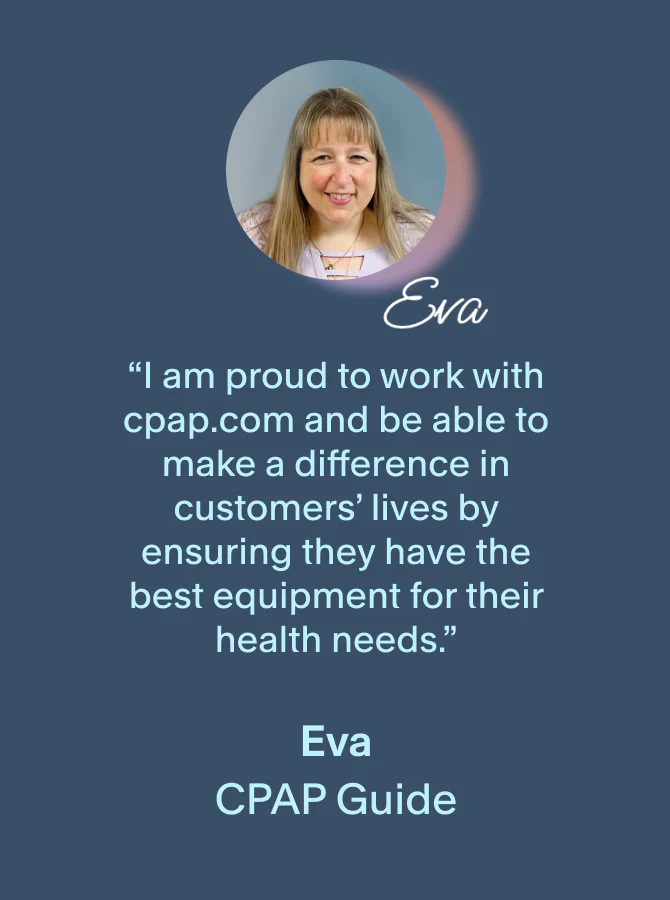Our content undergoes rigorous expert review, evidence-based research, and regular updates for accuracy.
One of the key parts of acclimating to your CPAP therapy is finding the right air pressure for you.
This isn’t always easy—especially if you have a CPAP machine that requires an exact pressure to be set. Auto-adjusting CPAP machines (APAP) are set to a certain pressure range and use self-adjusting algorithms. APAP machines use the input they receive from your breathing, meaning they’re typically easier to get adjusted to.
It can take time and adjustments to get your CPAP pressure settings just right for you. There isn’t a right or wrong pressure setting—the right one is the one that treats your sleep apnea and gives you a restful night of sleep.
By finding your ideal CPAP pressure, you can ensure that you are using your CPAP therapy in a way that is comfortable, safe, and effective, while also preventing any potential side effects.
What Is the Average Pressure for Treating Sleep Apnea?

When you first start using CPAP therapy for sleep apnea, your doctor will have you go through a process known as titration to arrive at the proper pressure prescription for you. This means that you will test out different CPAP pressure levels until your ideal therapeutic level is reached.
The average machine can auto-adjust between 4 and 20 centimeters of water (cmH2O). CmH2O is the unit that measures the pressure in CPAP machines and the centimeters of water pressure. One cmH2O is the amount of (additional) air pressure needed to raise a column of water by one centimeter. Think of it this way: if the pressure is set at ten cmH2O, then this would be like drinking water through a ten-centimeter straw.
The most common pressure setting for a CPAP machine is 10 cmH2O, and the average pressure levels for treating Obstructive Sleep Apnea (OSA) range from 6 to 15 cmH2O. In some cases, a person may require a higher or lower pressure than that 4 to 20 range.
Those with Central Sleep Apnea (CSA)—one of the three types of sleep apnea—may need a lower setting than four. If you need a BiPAP machine, the odds are that you may need more than 20 cmH2O for your expiratory setting. If you find yourself struggling to exhale while using a CPAP or APAP machine, talk to your doctor about switching to a BiPAP instead, which has a different pressure setting for inhaling and exhaling.
The highest pressure available on your CPAP machine will depend on the model you own, but in most cases, CPAP pressure settings max out at 20 cmH2O.
How to Tell if Your CPAP Pressure Needs Adjusting
Your CPAP machine needs a check-up every so often—just like your body. If your CPAP therapy is feeling uncomfortable, you are still tired after getting your recommended hours of sleep, your sleep was poor quality, or you are starting to feel sick after not enough quality sleep, it might be time to see if you need to have your CPAP pressure adjusted.
As a matter of fact, not having the right pressure dialed in is akin to not having CPAP therapy at all. You’ll continue experiencing the same problems you had before you started your CPAP therapy, such as difficulty breathing while asleep and loud snoring—although the latter may be indicative of a leaky mask.
Another pressure-related woe is if you wake up from your set CPAP pressure. You could indeed need an adjustment, but this is a common problem for new CPAP wearers who are getting adjusted to the pressure. Some new CPAP wearers report waking up in the morning without their mask on and do not recall removing it during the night. If you do this more than a few times when you start your CPAP therapy, it’s likely you’re using the wrong mask or your pressure needs a tweak.
If your pressure was always set at a certain cmH2O level and now it’s waking you up, it’s time for a new titration study. However, if you’re new to CPAP therapy and are experiencing issues, give it a few more nights to get used to CPAP therapy.
Feeling uncomfortable due to the pressure setting may be a sign that you need to titrate your treatment up or down. Pay careful attention to how you feel during treatment, throughout the night, and the day after to gauge whether you are using the right level of pressure.
What Are the Side Effects of Your CPAP Pressure Being Too High?
Getting a level of pressure that is enough to keep your airway open in a safe manner is essential. However, there is such a thing as ‘too high’ when it comes to your CPAP settings. If your CPAP pressure is too high, your symptoms and side effects can include:
- Significant air leaks from your mask
- Dry mouth and throat, even when you are using heated humidification
- Aerophagia—a condition that causes a CPAP wearer to “swallow” air into their stomachs and can result in bloating, gas, stomach cramps, and excessive burping
- An Apnea-Hypopnea Index (AHI) above the normal five events per hour
- Feeling tired or fatigued during the day
Additionally, some experts worry that setting your CPAP pressure too high can lead to pressure-induced CSA. In contrast to OSA, which is caused by your airways being blocked, CSA is the result of the breathing signals failing to be sent from your brain.
How Do I Adjust My CPAP Pressure?
It is not advisable for individuals to adjust their CPAP pressure themselves. If you are having trouble with your pressure levels, you can ask your doctor to order a new titration study to evaluate the right level of pressure for you.
Another option to discuss with your doctor is switching to an auto-adjusting CPAP machine (APAP). APAPs automatically adjust your pressure throughout your therapy, which greatly reduces the chances of having a pressure that is too high.
Your machine may also have a CPAP pressure relief setting—called expiratory pressure relief (EPR). EPR allows you to adjust between three different comfort settings to alleviate any feeling of breathlessness.
What Type of CPAP Masks Are Best for High Pressures?
Mask choice is extremely personal and varies from person to person. One that works well for you may be a poor fit for another CPAP wearer. This is because we all have different mask needs based on which of the three types of sleep apnea you’re treating, face shapes, amount of facial hair, sleeping positions, and all the other factors that go into finding the perfect mask for you.
Typically, CPAP wearers requiring higher rates of cmH2O are better off with a full face CPAP mask, but there are some nasal ones that can also do the job.
Frequently Asked Questions About CPAP Pressure
What Should My CPAP Pressure Be Set At?
Your CPAP pressure should be set to the pressure or range at which you experience the most significant reduction in your AHI, or the average number of apnea events you experience per hour. Most CPAP machines are capable of running at a pressure between 4 and 20, and the only pressure or range your machine “should be” set to is determined by your healthcare provider.
Typically, the more severe your sleep apnea is, the higher your air pressure will be. However, the exact number is determined by your doctor using the results of your sleep study. The goal is to have a pressure setting that is high enough to minimize your snoring and reduce the number of sleep apnea episodes that you experience per hour.
What Happens if Your CPAP Pressure Is Too High?
If your CPAP pressure is too high, it can lead to discomfort in the mouth, nose, and airway. Other signs include nasal congestion, sore throat, swallowing air, stomach pain, difficulty exhaling, and air leaks. These issues can cause you to wake up throughout the night and may even impact the effectiveness of your CPAP therapy.
Can I Reduce My CPAP Pressure?
You should never attempt to change your CPAP pressure yourself. This process should always be performed by a professional after your healthcare provider has determined the correct pressure setting. If you think your CPAP pressure should be lower, speak to your healthcare provider about what you’ve been experiencing.
Does Reducing Your CPAP Pressure Make Your CPAP Therapy Less Effective?
Reducing your pressure settings may increase the effectiveness of your CPAP therapy if your CPAP pressure is too high and makes you uncomfortable. Finding the right air pressure setting is very important, but if you lower your CPAP pressure to a point that it is too low, your sleep apnea treatment may become less effective. For this reason, you should only ever make changes to your therapy pressure after consulting your healthcare provider.
If you’re experiencing issues with dryness from high pressure, you may find relief by increasing your humidity level instead.
Final Thoughts
While the severity of your sleep apnea plays a large role in determining your pressure, so do naturally occurring changes in your body, such as getting older, gaining or losing weight, or any other events that alter your physiology.
As you go through different stages in life, you’ll find that you might need multiple pressure adjustments over the years. Monitor how you’re feeling while using your CPAP therapy to achieve your best night of sleep.











